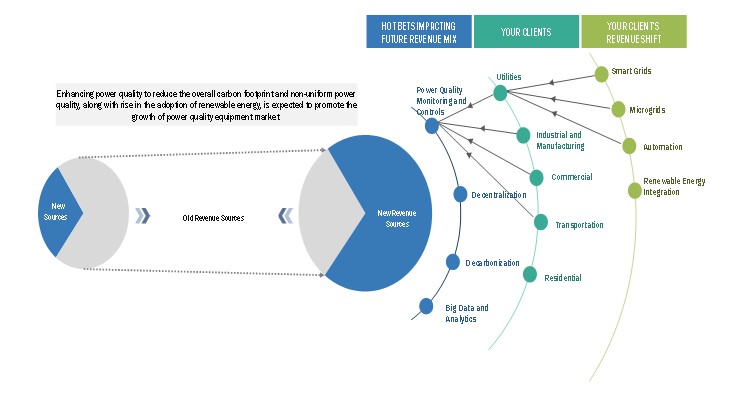
Global Power Quality Equipment Market Scenario:
The power quality equipment market size will grow to USD 46.1 billion by 2026 (forecast year) from USD 32.4 billion in 2021 (estimated year), at a CAGR of 7.3% during the forecast period. Reducing overall carbon footprint from electrical devices by improving power quality and maximizing financial costs and energy savings are the key factors driving the growth of the power quality equipment market. The worldwide increase in adoption of smart grid technologies and the integration variable renewable energy with power grids are expected to offer profitable opportunities for the power quality equipment market during the forecast period.
Download PDF Brochure – https://www.marketsandmarkets.com/pdfdownloadNew.asp?id=110225967
Opportunities: Integrating variable renewable energy with power grids
Power quality is an important aspect of renewable energy integration. One of the key power quality concerns is voltage and frequency fluctuations, which are caused by non-controllable variability in renewable energy resources. Wind and solar power generation is intermittent in nature owing to the variability in energy generation sources that require additional actions to balance the system.
The supply-side variability requires to be accommodated. This leads to the need for power quality equipment. The relationship between generation levels and loads has to be balanced by adopting methods to ensure increased grid flexibility. In instances wherein renewable energy generation increases and load levels fall (or vice versa), actions to balance the system are required. System operators need to ensure that they have sufficient resources to accommodate significant up or down ramps in renewable energy generation to maintain system balance. Another power quality issue faced due to renewable energy integration is harmonics, which are introduced by power electronic devices used for renewable energy generation. When penetration level of renewable energy is high, the influence of harmonics is expected to be significant. Hence, balancing of loads to avoid tripping of electrical equipment offers lucrative growth opportunities for the power quality equipment market.

Challenges: Increasing use of nonlinear equipment across the world
The current waveform is not sinusoidal for nonlinear loads in sinusoidal AC circuits, as these loads comprise devices with no current conduction over the full cycle of the applied voltage. Nonlinear loads result in several disturbances such as overheating in distribution transformers and other distribution equipment, voltage waveform distortion, higher than rated currents in circuits, and heating in neutral conductors. They also affect the amplitude of the network voltage, change the phase relationship between the supply voltage and current, and cause distortion to the sinusoidal wave shape of the supply. Nonlinear loads not only reduce the power quality considerably but are also very sensitive to poor power quality in power distribution networks.
For instance, the compact fluorescent lamps (CFL) draw ~75% lower current than the incandescent bulbs, which were used previously. The ballasts integrated with CFL provide them a long lifespan, but they also distort the waveform of the current being drawn. Hence, considerable harmonic distortions are introduced into residential power distribution networks. The extensive use of nonlinear loads in appliances such as television sets, computers, stereos, microwaves, CFL, LED lighting, and chargers introduce harmonic distortions and compromise the power quality.
Ask FREE Sample Pages- https://www.marketsandmarkets.com/requestsampleNew.asp?id=110225967
Asia Pacific likely to emerge as the fastest growing
In this report, the power quality equipment market has been analyzed for five regions, namely, North America, South America, Europe, Asia Pacific, Middle East & Africa. Asia Pacific is expected to grow at the highest CAGR during the forecast period. Asia Pacific region has been segmented, by country, China, Japan, India, and the Rest of Asia Pacific (South Korea, Australia, Thailand, Vietnam, and Malaysia). The power quality equipment market in Asia Pacific is dominated by China and India. The surging demand for electricity and the growing requirement to increase renewable power generation capacity encourage utilities in these countries to invest in transmission and distribution infrastructures. Asia Pacific is expected to invest USD 9.8 billion in developing smart grid infrastructures from 2018 to 2027. In addition, the development of smart grids in countries such as China, Japan, South Korea, and India is supported by regulations that either encourage or mandate their development. The power quality equipment market in China is projected to grow at the highest CAGR from 2021 to 2026.
Key Market Players:
Some of the key players are Siemens (Germany), ABB (Switzerland), Eaton (Ireland), Schneider Electric (France), and General Electric (US). The leading players are adopting various strategies to increase their share in the power quality equipment market.
